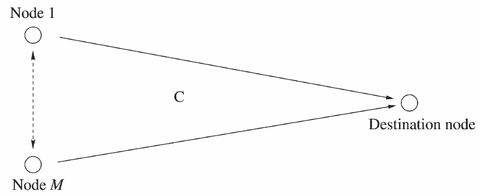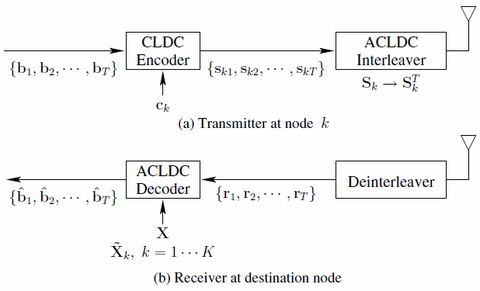Summary
In this work, a family of asynchronous cooperative linear dispersion codes (ACLDCs) capable of maintaining full diversity in cooperative scenarios have been investigated even in the presence of asynchronous reception. The linear dispersion structure is employed to accommodate the dynamic topology of cooperative networks, as well as to achieve higher throughput than conventional space–time codes based on orthogonal designs. By introducing guard intervals and block encoding/decoding techniques, the interference signals caused by asynchronous reception can be exploited rather than discarded.
Description
The space–time block coding (STBC) techniques provide full spatial diversity in the context of collocated multiple-input–multiple-output (MIMO) systems, requiring reliable wireless communications at high rates. However, it may not always be practical to accommodate multiple antennas at the mobile nodes in the network, owing to cost, size, and other hardware limitations. As a remedy, the concept of “cooperative diversity” has been proposed in the literature, providing diversity using single antennas of other nodes in the network.
Furthermore, it is often the case that propagation delays experienced by the signals from cooperative nodes are different, even if these nodes are scheduled to simultaneously transmit. Thus, the composite pulse seen at the receiver, which is the sum of the pulses from each transmitter shifted by the corresponding propagation delay, will no longer be Nyquist. Hence, intersymbol interference (ISI) is generated after sampling at the receiver, where a similar phenomenon is observed with frequency-selective channels. In general, there are three classes of techniques in the open literature to deal with the issue of ISI, which are time-domain approaches, frequency-domain solutions, and the use of a conventional equalizer.
In this paper, we propose a novel time-domain STBC scheme by combining the features of both LA-STBCs and TR-STBCs to combat imperfect synchronization in cooperative MIMO systems, namely, asynchronous cooperative linear dispersion codes (ACLDCs). The rationale and novelty of the proposed
ACLDCs are given in the list that follows.
- The proposed scheme is capable of dealing with an arbitrary propagation delay difference τ while maintaining full spatial diversity, provided that sufficient guard intervals are appropriately inserted, as opposed to certain delays of LA-STBCs and distributed-TAST codes.
- The proposed scheme features high-rate transmissions, whereas the TR-STBCs are unable to have a symbol rate higher than unity.
- The ACLDC scheme consists of a space–time encoder to achieve full spatial diversity and a block encoder (or interleaver) to combat the propagation delay, which are designed jointly, rather than separately.
- The proposed ACLDCs maintain a flexible linear dispersion structure, which supports an arbitrary number of nodes to cooperate, while supporting arbitrary modulation schemes.



